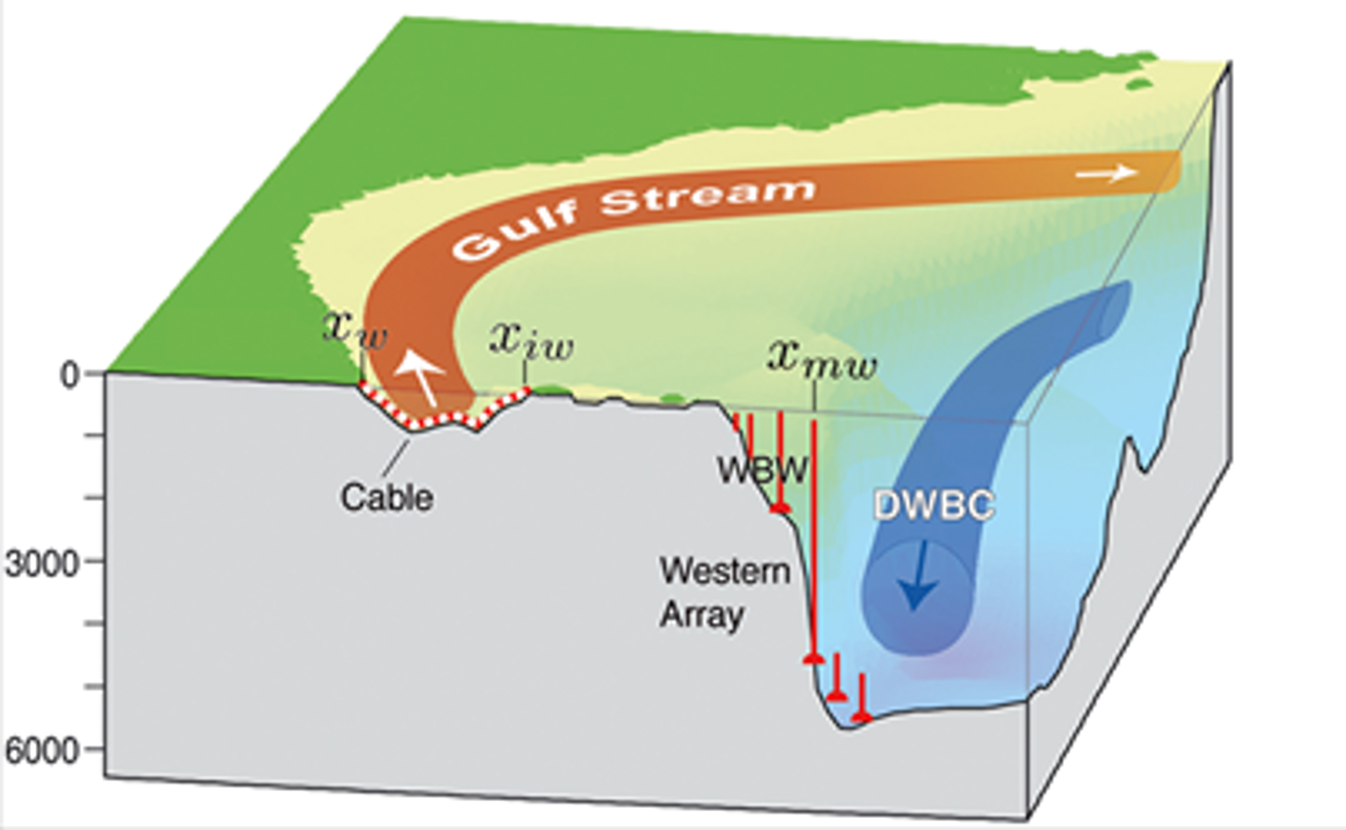
Peter Ditlevsen and Susanne Ditlevsen are scientists at the University of Copenhagen in Denmark. Being scientists, they enjoy gathering data and creating complex quadratic equations to describe changes in the Earth’s environment. Using data supplied by sensors in the North Atlantic, they say there is ample evidence that the Atlantic Meridional Overturning Circulation — popularly known as the Gulf Stream — could collapse as early as 2025 or as late as 2095.
Choose whichever date you prefer. Either way, people you know and love today will still be alive when it happens. If you have a grandchild who is 12 years old today, he or she will have reached the ripe old age of 84 when the AMOC shuts down. That’s the best case scenario. In the worst case scenario, that precious grandchild who you love more than life itself won’t even be Sweet 16 when the Gulf Stream comes to a halt.
What Is The Gulf Stream?

Courtesy of NOAA
The Gulf Stream carries warm ocean water northwards towards the Arctic, where it cools and sinks, driving the circulation in the North Atlantic. An influx of freshwater from the accelerating melting of Greenland’s ice cap and other sources is smothering the AMOC current.
What happens when the Gulf Stream collapses? According to The Guardian, it will severely disrupt the rains that billions of people depend on for food in India, South America, and West Africa. It will increase storms and lower temperatures in Europe. It will lead to rising sea levels on the east coast of North America and further endanger both the Amazon rain forest and Antarctic ice sheets. “I think we should be very worried,” says Peter Ditlevsen. “This would be a very, very large change. The AMOC has not been shut off for 12,000 years.”
The Gulf Stream collapsed and restarted repeatedly during the ice ages that occurred from 115,000 to 12,000 years ago. It is one of the climate tipping points scientists are most concerned about as global temperatures continue to rise.
The new study, published July 25 in the journal Nature Communications, used sea surface temperature data stretching back to 1870 as a proxy for the change in strength of the Gulf Stream over time. They compared the date to the path seen in systems that are approaching a particular type of crossover point called a “saddle-node bifurcation.” We would call it a “tipping point.”
The data fit that model “surprisingly well,” Ditlevsen said. Then the researchers were able to extrapolate the data to estimate when the tipping point is likely to occur. The calculations assume the world keeps on pouring the same level of toxic waste into the atmosphere in the future as it does today.
Nothing To See Here, Move Along
While you might think that would be stupid, it is exactly what the oil and gas industries intend to do, come hell or high water. Last week we republished a blog post by Bill McKibben about how BlackRock, the largest asset manager in the world, is backing away from its pledge to take environment, sustainability, and governance considerations into account in its investment decisions.
It should be noted that the jackasses running the Red States in America have declared war on any financial institutions that dare to consider the best interests of the Earth in their business decisions. Just today, the oil companies are jumping for joy because more oil has been discovered beneath the Gulf of Mexico, which can be extracted and burned to create even more climate-destroying carbon emissions. The Gulf of Mexico is already approaching the temperature of a hot tub. Surely a few million more gigatons of carbon pollution will hardly be noticed, right?
Climate Uncertainty
The most recent assessment by the Intergovernmental Panel on Climate Change concluded that the Gulf Stream would not collapse this century, but Peter Ditlevsen says the models used by IPCC have a coarse resolution and are not adept at analyzing the non-linear processes involved, which may make them overly conservative.
Not all climate scientists agree with the timeline the Ditlevsens suggest, and that gives cover to the deniers who can claim that there is doubt about the findings. They are right, there is — just as there is doubt about when Tesla will build its ten millionth automobile. But just because the exact day and hour cannot be predicted with accuracy does not mean the odds of something happening are zero. Changes in the Earth’s environment are coming, changes that will threaten the existence of the human race and most of the species that currently exist on our planet.
Professor Niklas Boers, from the Potsdam Institute for Climate Impact Research in Germany, revealed the early warning signs of AMOC collapse in 2021. “The results of the new study sound alarming but if the uncertainties in the heavily oversimplified model [of the tipping point] and in the underlying [sea temperature] data are included, then it becomes clear that these uncertainties are too large to make any reliable estimate of the time of tipping.”
The extrapolation in the new analysis was reasonable, according to Professor Tim Lenton of the University of Exeter, who said the tipping point could lead to a partial Gulf Stream collapse. For example, it might only shut down in the Labrador Sea, but this would still cause major impacts.
The Takeaway
The statistic that should get everyone’s attention is this one: According to a study published in May of this year, the burning of fossil fuels has added the heat of 25 billion atomic bombs such as the one that was dropped on Hiroshima. Think about that. Forget how many gazillion tons of carbon dioxide have been dumped into the atmosphere over that period of time.
In what world does anyone think we can add that much heat and not have a negative effect on our environment? At what point do we say, “This is insanity?” When do we stop adding more, and more, and still more heat to our environment?
We have known that global heating was an issue at least since Dr. James Hansen gave his historic testimony to Congress 35 years ago. And yet we have refused to listen and now there is a virulent coterie of fossil fuel apologists loose across the internet and around the world who would have us extend the reign of fossil fueled madness even as our seas boil, or forests burn, and our cities become too hot to step outside.
As Pete Seeger asked in 1955, “When will they ever learn? When will they ever learn?” The answer, apparently, is never.
I don’t like paywalls. You don’t like paywalls. Who likes paywalls? Here at CleanTechnica, we implemented a limited paywall for a while, but it always felt wrong — and it was always tough to decide what we should put behind there. In theory, your most exclusive and best content goes behind a paywall. But then fewer people read it! We just don’t like paywalls, and so we’ve decided to ditch ours. Unfortunately, the media business is still a tough, cut-throat business with tiny margins. It’s a never-ending Olympic challenge to stay above water or even perhaps — gasp — grow. So …




